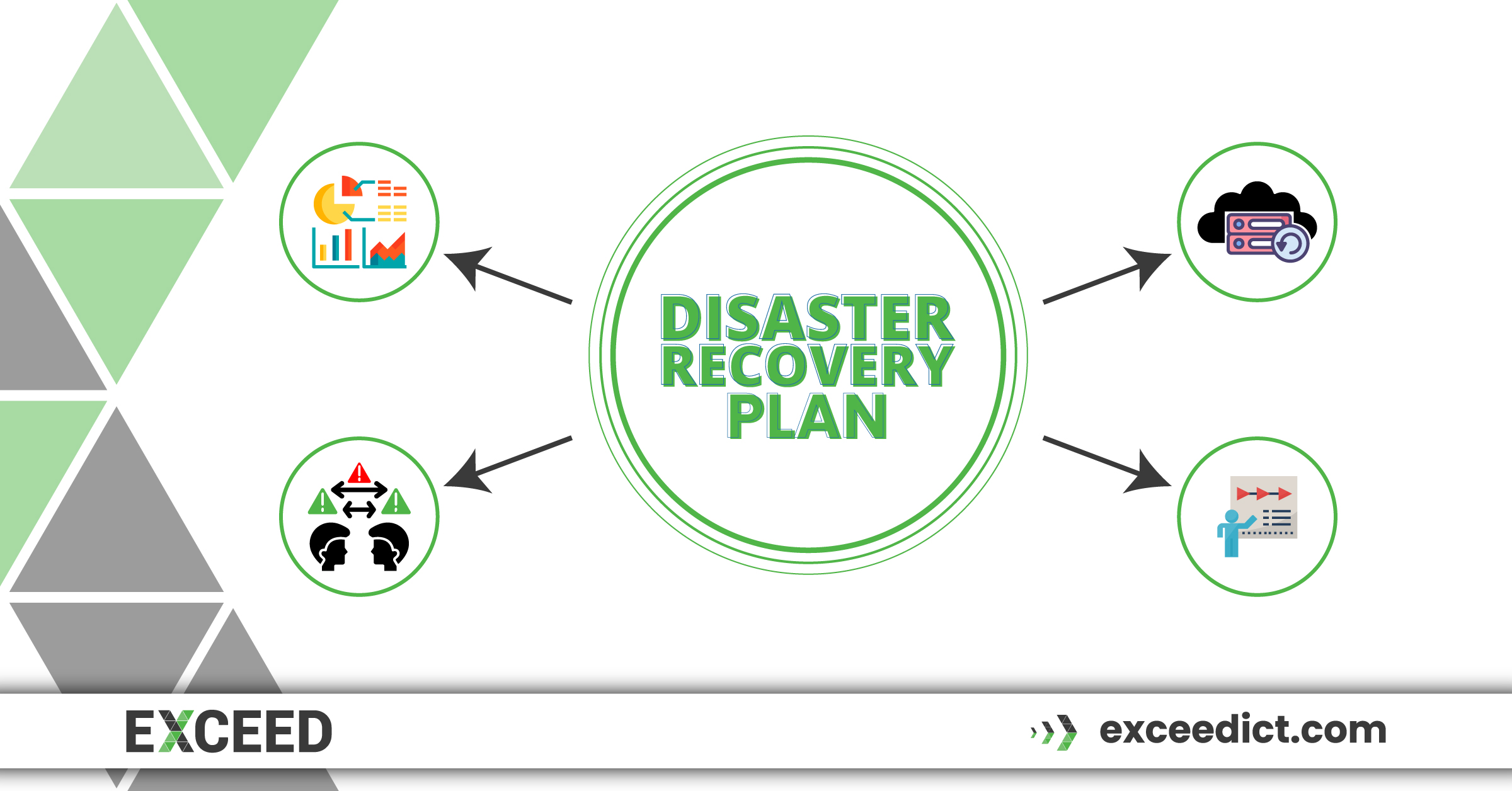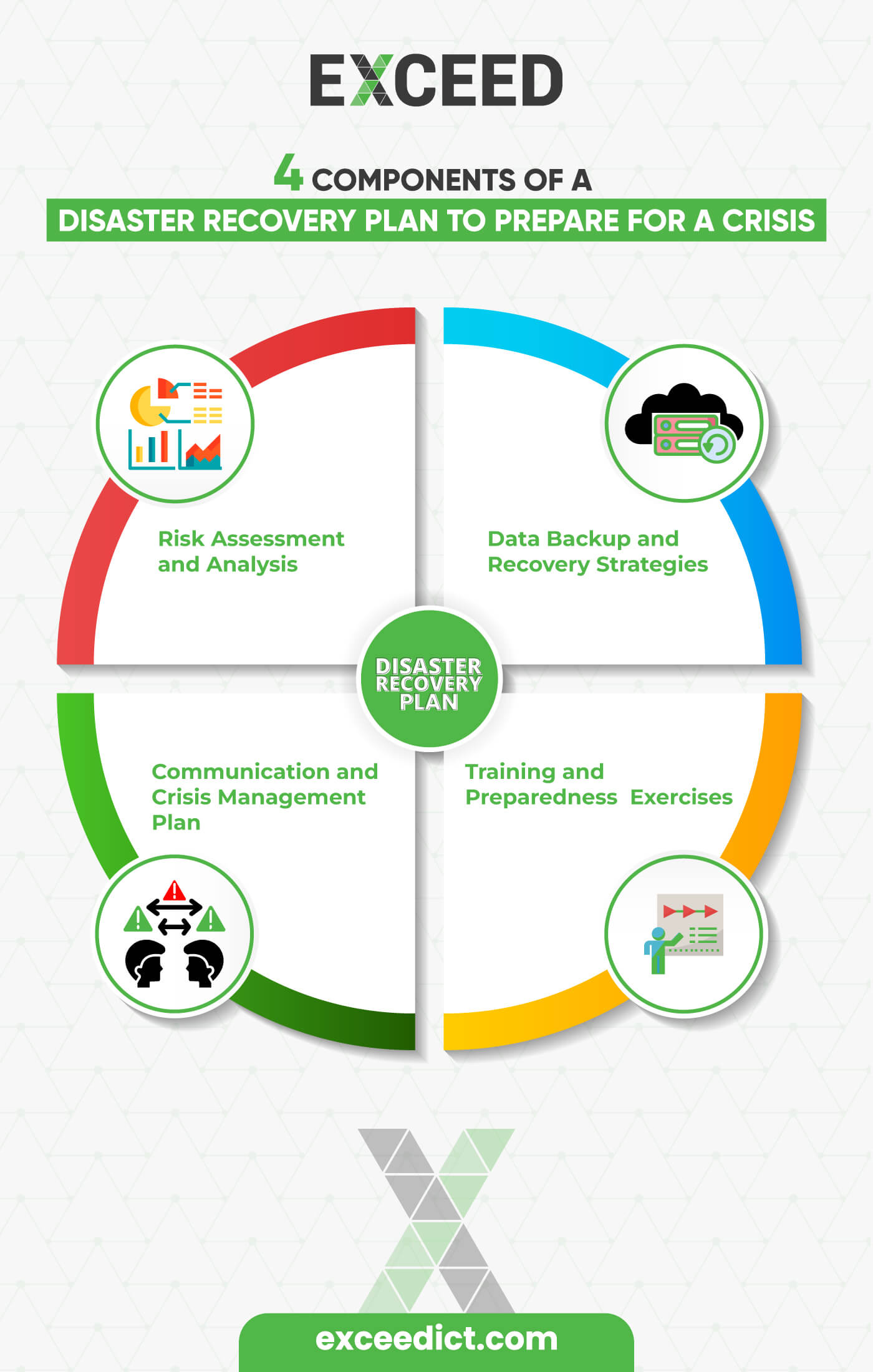
4 components of a disaster recovery plan
 In today’s uncertain world, having a robust disaster recovery plan is not just a smart business decision; it is a necessity. Natural disasters, cyber-attacks, pandemics, and other unforeseen crises can cripple businesses and organisations that are unprepared.
In today’s uncertain world, having a robust disaster recovery plan is not just a smart business decision; it is a necessity. Natural disasters, cyber-attacks, pandemics, and other unforeseen crises can cripple businesses and organisations that are unprepared.
To safeguard your operations, assets, and data, you need a comprehensive disaster recovery plan that covers all aspects of crisis management.
In this article, we will explore the 4 components of a disaster recovery plan that will help you prepare for a crisis effectively.
From risk assessment and data backup strategies to communication plans and employee training, we will delve into the essential elements that make up a successful disaster recovery plan.
4 Components of a Disaster Recovery Plan to Prepare for a Crisis
Component 1: Risk Assessment and Analysis
 One of the fundamental pillars of a disaster recovery plan is conducting a thorough risk assessment and analysis. This process involves identifying potential hazards, evaluating their impact on your business, and understanding the likelihood of their occurrence. A comprehensive risk assessment will enable you to prioritise your disaster recovery efforts and allocate resources efficiently.
One of the fundamental pillars of a disaster recovery plan is conducting a thorough risk assessment and analysis. This process involves identifying potential hazards, evaluating their impact on your business, and understanding the likelihood of their occurrence. A comprehensive risk assessment will enable you to prioritise your disaster recovery efforts and allocate resources efficiently.
Key Steps in Risk Assessment:
- Identifying Potential Risks: Begin by creating a list of all potential risks that could affect your business, such as natural disasters, power outages, cyber-attacks, and supply chain disruptions.
- Quantifying Impact: Assess the potential impact of each risk on your business operations, financials, reputation, and customer trust.
- Likelihood Evaluation: Determine the likelihood of each risk occurring, considering historical data and industry trends.
- Prioritising Risks: Rank the identified risks based on their severity and probability, focusing on the most critical ones first.
Component 2: Data Backup and Recovery Strategies
Protecting your data is paramount in a disaster recovery plan. Data loss can be catastrophic for any organisation, leading to significant financial losses and damaging your reputation. Implementing robust data backup and recovery strategies is essential to ensure business continuity even in the face of a crisis.
Key Data Backup and Recovery Strategies:
- Regular Backups: Establish a routine backup schedule for all critical data, applications, and systems. Cloud-based backups are highly recommended for added security.
- Offsite Storage: Keep backup copies of data in offsite locations to safeguard against physical damage to your primary infrastructure.
- Data Recovery Testing: Regularly test the data recovery process to verify the integrity of backups and identify potential issues.
- Redundancy and Failover Systems: Implement redundant systems and failover mechanisms to ensure seamless operations during data recovery.
Component 3: Communication and Crisis Management Plan
During a crisis, effective communication is vital to coordinate response efforts and keep stakeholders informed. A well-defined communication and crisis management plan will help you maintain transparency, build trust with customers, and minimise the impact of the disaster.
Key Elements of Communication and Crisis Management Plan:
- Crisis Communication Team: Designate a crisis communication team responsible for disseminating information both internally and externally.
- Message Consistency: Ensure that all communication is consistent and aligned with your brand’s values and mission.
- Media and Public Relations: Establish guidelines for dealing with the media and public during a crisis to control the narrative effectively.
- Employee Communication: Keep your employees informed and engaged throughout the crisis, providing clear instructions and support.
Component 4: Training and Preparedness Exercises
A disaster recovery plan is only as effective as the people executing it. Proper training and preparedness exercises are essential to ensure that your employees know their roles and responsibilities during a crisis. Regular drills and simulations will help identify weaknesses and fine-tune your disaster response strategies.
Training and Preparedness Activities:
- Employee Training: Conduct regular training sessions to educate employees about the disaster recovery plan, emergency procedures, and safety protocols.
- Tabletop Exercises: Organise tabletop exercises where teams simulate crisis scenarios and practise their response strategies.
- External Collaboration: Collaborate with local emergency services and community organisations to enhance your disaster response capabilities.
- Lessons Learned Analysis: After each preparedness exercise or real crisis, conduct a thorough analysis of the response to identify areas for improvement.
Frequently Asked Questions (FAQs):
What are the 4 components of a disaster recovery plan to prepare for a crisis?
The four components are risk assessment and analysis, data backup and recovery strategies, communication and crisis management plan, and training and preparedness exercises. Each element plays a crucial role in ensuring your business is ready to handle any disaster effectively.
Why is risk assessment important in a disaster recovery plan?
Risk assessment helps identify potential threats and vulnerabilities that could impact your business during a crisis. By understanding these risks, you can prioritise your efforts and allocate resources efficiently to minimise the impact of a disaster.
What are the best data backup strategies for disaster recovery?
Regular backups, offsite storage, data recovery testing, and redundancy with failover systems are essential data backup strategies. Storing backup copies in secure cloud-based solutions adds an extra layer of protection.
How does effective communication contribute to crisis management?
Effective communication is crucial during a crisis as it helps coordinate response efforts, keeps stakeholders informed, and maintains transparency. A well-managed crisis communication plan can protect your reputation and build trust with customers and employees.
Why is employee training essential for disaster preparedness?
Employee training ensures that your staff knows how to respond during a crisis, reducing confusion and enhancing the effectiveness of your disaster recovery plan. Regular drills and exercises help employees become familiar with their roles and responsibilities.
What is the importance of conducting post-crisis analysis?
Post-crisis analysis, also known as a lessons learned analysis, is vital for continuous improvement. It allows you to identify strengths and weaknesses in your response, enabling you to refine your disaster recovery strategies for future incidents.
In conclusion, a well-crafted disaster recovery plan is a lifeline for businesses and organisations facing potential crises. By incorporating the 4 components outlined in this article—risk assessment, data backup, communication plan, and training—you can significantly enhance your preparedness and response capabilities.
Remember, preparation is the key to mitigating the impact of a disaster. Regularly review and update your disaster recovery plan, engage your employees in preparedness exercises, and maintain open lines of communication with stakeholders. With a robust disaster recovery plan in place, you can confidently navigate through any crisis that comes your way.
You may also like to know more about
- Disaster Recovery Plan template and Examples with Checklist
- Business Continuity Planning vs Disaster Recovery Planning.
- Step by Step Guide for a business continuity plan.
- What is Business Continuity Planning? Importance, Risk Assessment, & Core Objectives.
- Understanding the Disaster Recovery Planning – steps, benefits and best practices.
- Disaster Recovery Planning To Ensure The Connectivity in Crisis.
Stay connected with EXCEED ICT
Stay connected with EXCEED ICT by joining our social networks (given at footer). Get the latest updates, news, and tips for enterprise device deployment. Follow us on Twitter, Facebook, and LinkedIn for the best enterprise device deployment solutions.
Help us to improve our enterprise by rating us on Google Maps. Your feedback and comments are valuable to us and will be used to make our services even better.


